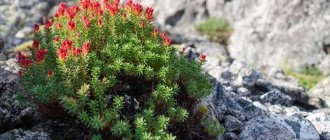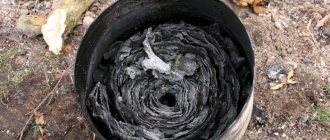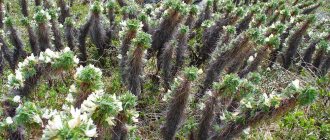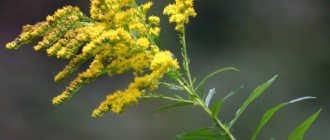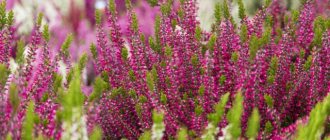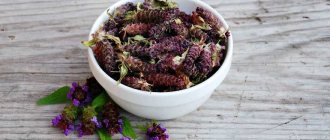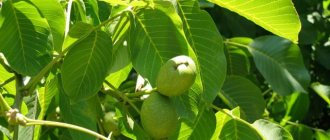Red brush grass description, photo
Rhodiola quadrifida (Rhodiola quadrifida) belongs to the Crassulaceae family. The plant has a lot of other names - Rhodiola four-membered, frosty, four-cut, red root. It is often called Siberian ginseng. It is endemic to such areas as the Altai Territory and the Angara-Sayan region. Grows near water sources, on rocky slopes.
Attention! This plant is listed in the Red Book as a rare and endangered species.
If you had a chance to see Rhodiola tetrapartite in person, you might not even pay much attention to it. The herbaceous perennial does not have an outstanding appearance, and its small growth (8-20 cm) covers modest bushes among taller growth.
This complicates the extraction of valuable raw materials - plant roots. It has a lot of branches and a pleasant aroma. Like most plants of the Crassulaceae family, Rhodiola frostis has a caudex - a woody core consisting of many layers of dead stems. It bears many thin straight stems, densely strewn with lanceolate leaves. They look like small fleshy needles, curved upward. Leaf length is about 2 cm, width 3 mm. If touched carelessly, the succulent leaves will certainly begin to fall off.
The color of the flower petals varies from cream to dark red. The perianth is red, the flowers are dioecious. They are collected in a corymbose inflorescence. Flowering occurs in June-July, after which the seeds begin to ripen.
The collection of rhizomes is carried out precisely in this short period of time: after the end of flowering and before the seeds ripen. There are a lot of them in the fruit, which looks like an elongated straight leaflet. The prepared raw materials are thoroughly dried in a dark, ventilated room. It retains its healing properties for two years.
This is interesting! Like all succulents, Rhodiola quadrifida stores water in its green leaves. It uses it up with the onset of unfavorable, dry conditions, which happen quite often in the mountains.
Red brush: medicinal properties and contraindications
Description of the plant: The scientific name of the red brush (Rhodiola quadrifida) is Rhodiola quadrifida, it is also called four-membered or four-part, Rhodiola cold, there is a name - Siberian ginseng.
The red brush plant is quite popular for its uniqueness. Almost 20 million websites talk about its medicinal properties, it is discussed on forums, but there are very few scientific publications about the red brush. Even the all-knowing Wikipedia does not provide information about him.
Probably because this plant is rare, endangered in many regions, harvesting on an industrial scale is impossible, so it is of little interest to the medical industry. In this connection, it is poorly studied.
But research is still being conducted, although not in our country. Scientists from China, Germany and Poland are studying the effect of red brush tincture in the fight against cancer. Experiments are carried out on mice, and the results are very encouraging.
Due to its divine properties, this plant is on the verge of extinction in many regions. Once upon a time, it grew here in Transbaikalia in the high alpine meadows of Buryatia, on the slopes of Sokhondo, but now it has been practically destroyed by people, now it is listed in the Red Book and is under state protection.
Also, it was included in the Red Book in Yakutia and Mongolia. Let's hope that the situation will change, the red brush will grow, its distribution area will expand, or the brush will be introduced into the culture and grown in beds on an industrial scale.
This plant is quite widespread in the highlands of Altai and Tuva, in the Sikhote-Alin, Sayan, and Barguzin ranges, where the collection of this herb is permitted and where it is currently harvested. The brush belongs to the genus Rhodiola, which has up to 90 different species. I have already written about one of the species, read, Rhodiola rosea.
The Rhodiola four-cut plant is dioecious and perennial, meaning the male and female flowers are on different plants. A low plant, its height is up to 20 centimeters, as it grows it forms buds with numerous erect stems covered with thick fleshy leaves, like all Crassulaceae. After all, this plant belongs specifically to this family - Crassulaceae.
The flowers are small, up to 3 mm, usually yellow, and their crowns are slightly red, but the flowers are collected in a corymb inflorescence, which grows to 1.5 - 2 centimeters in diameter, so the flowers look impressive. The brush blooms in June-July, and after flowering it forms seeds. The taproot is up to 2 cm in diameter.
The plant is collected manually, immediately after flowering. Only the roots of the plant are used for medicinal purposes. Dry the collected raw materials in the shade and so that the place is well ventilated. Dried roots can be stored for two years.
Chemical composition of the plant
Incredible adaptability to survival in harsh mountainous areas has endowed Rhodiola frostis with the ability to accumulate useful substances in its rhizome. It contains the following substances:
- Anthraglycosides. These substances stimulate intestinal motility and have an antimicrobial effect. The most prominent in this group of substances is salidroside, which has powerful anti-inflammatory and oncoprotective properties. Based on salidroside, scientists are developing experimental cancer drugs. It slows down oxidative processes in cells and protects them from premature aging, and is a powerful adaptogen.
- Essential oils. They have bactericidal, immunomodulatory, analgesic and sedative properties.
- Phenols. These chemical compounds affect the permeability of the walls of blood vessels, which will protect you from the formation of cholesterol plaques. They have anti-inflammatory and antifungal properties.
- Organic acids. They are responsible for the synthesis of blood cells, participate in metabolism, and break down fats. They help remove free radicals and toxins and strengthen the immune system.
- Sterols. Regulate the functioning of the cardiovascular system, protect against autoimmune reactions.
- Tannins and waxes. They have an anti-inflammatory, astringent, wound-healing effect.
- Flavonoids. Powerful antioxidant. Helps in the fight against the toxic effects of various substances. It has a beneficial effect on all body systems - digestive, cardiovascular, nervous, reproductive, immune, endocrine.
- Phytohormones. They regulate hormonal levels, reduce blood pressure, restore reproductive function, and regulate the functioning of the adrenal glands.
- Betaines. They provide protection against stress, are a hepatoprotector, and increase joint mobility by reducing the viscosity of the synovium.
Know! Indigenous Altai people claim that the healing power of Rhodiola quadrifidum can help even a seriously ill person.
In addition to biologically active substances, the rhizome is rich in microelements:
- Zinc. Regulates the functioning of the reproductive system of men and women. Stimulates brain activity. Participates in metabolism at the cellular level. Responsible for the development of bone tissue and insulin synthesis.
- Nickel. Responsible for protein metabolism and synthesis of DNA molecules. Regulates prolactin levels.
- Manganese. Participates in lipid and carbohydrate metabolism, insulin production. Stimulates the production of blood cells. Restores the female reproductive system.
- Cobalt. A powerful antioxidant that promotes the production of antibodies and blood cells.
- Selenium. Oncoprotector and immunomodulator. Responsible for the functioning of sex hormones. In women it reduces the symptoms of menopause, in men it increases sperm motility.
- Chromium. Responsible for carbohydrate metabolism. Helps in the fight against diabetes by reducing blood glucose levels. Eliminates cholesterol plaques, helps lower blood pressure.
- Copper. Responsible for the synthesis of hemoglobin, increasing resistance to oxygen starvation. It has oncoprotective and immunostimulating effects.
- Molybdenum. Participates in carbohydrate and fat metabolism, stimulates cell growth. Responsible for iron metabolism in liver cells.
Know! In addition to all the listed components, the composition of the red brush includes a high-molecular carbohydrate - gum. It removes toxins from the body and reduces the side effects of antibiotics.
Useful and healing properties
The chemical composition of Rhodiola frostis, selected by nature, makes it an excellent remedy with the following properties:
- rejuvenating;
- adaptogenic;
- antispasmodic;
- sedative;
- hemostatic;
- immunomodulatory;
- anti-inflammatory;
- oncoprotective;
- antiviral, antifungal, antibacterial.
The uniqueness of this plant is that it has a healing effect at the cellular level. The components of the rhizome help eliminate the direct cause of the disease, and not its consequence. It is also important that Rhodiola quadrupartum stimulates its own immunity to fight the pathogenic influences of the external environment.
It is successfully used as an independent remedy or in complex treatment of the following diseases:
- cardiovascular system: leukemia, anemia, arterial and intracranial hypertension, atherosclerosis, inflammation of the lymph nodes;
- gynecological and urological diseases: neoplasms of various origins, localized in the ovaries and uterine cavity, amenorrhea, mastopathy, pyelonephritis, menopausal syndrome, ectopia, infertility, cystitis;
- endocrine disorders: goiter, hypothyroidism, diabetes;
- diseases of the central nervous system: epilepsy, neurosis, cerebral vasospasm, concussion;
- pathologies of the male reproductive system: prostatitis and prostate adenoma, oligospermia, sexual dysfunction, impotence, infertility;
- wounds and injuries of various etiologies: you can successfully accelerate the process of healing and regeneration of bone tissue, epidermis, dermis;
- infections of various origins: fungal, viral and bacterial infections;
- immune defense disorders;
- diseases of the gastrointestinal tract: cholecystitis, gastritis, colitis;
- oncological diseases.
Important! Often, preparations based on Rhodiola quadruple are used to replenish physical activity. They are especially relevant for athletes, because they are not doping.
Contraindications and possible harm
Despite the many medicinal properties, there are conditions for which the use of a red brush is not recommended. Contraindications include a tendency to insomnia, pregnancy, hypertension, allergic reactions and individual intolerance, and heart problems. Also, you should not use plant-based preparations during menstruation, fever, or lactation.
It is not recommended to simultaneously take preparations based on Rhodiola and contraceptives, as well as plants containing phytohormones (licorice, hops and others, with the exception of hogweed). You need to start using the drugs with small doses, gradually increasing them and monitoring the body’s reaction.
If excessive drowsiness and lethargy are observed, which are side effects of using drugs based on red brush, the drug should be discontinued. During the course of herbal treatment, it is not recommended to drink alcohol and fatty foods.
Application: truth and myth
The red brush is used in the treatment of gynecological and urological pathologies. It is used to cleanse the blood, activate the immune system, increase efficiency, and remove waste and toxins.
Gastroenterologists also recommend medicines with Siberian ginseng root. Anthraglycosides gently weaken and enhance intestinal motility. Complex therapy with antitumor drugs gives excellent results. Antioxidants help slow the growth of cancer cells.
Cosmetologists note the regeneration of skin cells and their overall rejuvenation. What causes this is not known for certain, but the chemical composition of the plant contains quite a lot of substances that promote cell regeneration and normalize the functioning of all body systems.
Endocrinologists include Rhodiola frostis in the category of biological hormonal agents; it helps maintain a healthy hormonal background of the entire endocrine system. In particular, it restores the normal secretion of sex hormones, insulin and hormones produced by the adrenal glands.
Know! Rhodiola quadrifidum has found application not only in folk medicine, it is officially recognized as a herbal medicine.
However, traditional medicine does not make much contribution to the research of the properties of this unique plant. This is explained quite simply: the red brush has a narrow growing area, and the extraction of medicinal raw materials is associated with some difficulties. Once the root is removed, the plant will die, which makes it irrelevant for large-scale production.
Scientists from China are not giving up attempts to industrially grow a healing endemic plant. Together with the Poles and Germans, they are conducting experiments to develop a real panacea - a cure for cancer.
As for the myths regarding the use of the plant, there simply are none. But there is a beautiful Altai legend about its origin: “In ancient times, one shaman was engaged in healing seriously ill people. One day he had a dream that was destined to come true. He watched a wonderful butterfly, the likes of which he had never seen in his life. Her flight ended at a strange flower that looked like a brush with a red head. He felt an unprecedented surge of strength and felt the healing properties of this plant.
Having awakened, the doctor repeated his wanderings in reality and found an unknown bush. He extracted its root, which, during the process of washing in a mountain stream, colored the water scarlet. So the shaman came up with a name for the new healing plant – red brush.”
This is interesting! Frosty Rhodiola received its popular name not only because of its external resemblance to the cleaning tool of the same name. Herbalists compare the result of its use with the effect of a brush, which restores cleanliness and order throughout the body.
Healing properties for men
The root of Rhodiola quadrifidum is a real panacea in the treatment of diseases of the male genital area. Men are reluctant to go to the doctor when various problems arise and very often take a banal sore to a serious condition. Use for preventive and therapeutic purposes will help in the presence of the following pathologies:
- inflammation of the prostate gland;
- violation of potency;
- oligospermia;
- infertility;
- BPH;
- decreased sperm activity.
The anti-inflammatory effect provided by the intake can defeat the cause of prostatitis - an inflammatory process caused by pathogenic microflora. The general tonic and adaptogenic effect perfectly fights stress and restores immune function, which has a beneficial effect on potency and sperm quality. And the presence of biological hormones can improve one’s own hormonal levels, restore confidence in masculine strength, restore potency and cure infertility.
Important! Rhodiola quadrifida also helps in the prevention of stroke and atherosclerosis, to which men are more susceptible.
Fans of poor nutrition, which contains a large amount of cholesterol, will benefit from preventive use of Rhodiola quadruple. It will help break down excess cholesterol and prevent it from forming congestion in the blood vessels, which will have a beneficial effect on blood and intracranial pressure.
Beneficial features
Red brush herb has a positive effect on the male and female genitourinary system. The plant copes with inflammatory diseases of the pelvic organs, eliminates congestion, and increases blood circulation.
Radiola normalizes hormonal levels, tones the body, stabilizes the endocrine system, and effectively fights infections.
The red brush can stop internal bleeding, overcome infertility, and restore male potency. It is necessary to buy red brush root and take it regularly for nervous disorders, stress, and fatigue.
Benefits for women
The female body experiences stress and hormonal imbalances at various times. The mild effect of phytohormones helps restore normal production of their own body. The tonic, adaptogenic and immunomodulatory effect of drugs that contain red brush will help women restore their natural strength and overcome many gynecological pathologies.
Women often resort to beauty recipes that have a beneficial effect on the condition of the skin, hair, nails, and have a rejuvenating effect. For this purpose, you can use a tincture or wash your face with a decoction of the roots.
Application in gynecology
The plant has found wide use in the treatment of gynecological diseases:
- fibroids and fibroids;
- mastopathy;
- polyps;
- uterine bleeding;
- menstrual irregularities;
- menopause;
- polycystic ovary syndrome;
- inflammatory processes in the pelvis – colpitis, candidiasis, ureaplasmosis, vulvovaginitis; infertility;
- ectopia (cervical erosion);
- oncological diseases.
The female body very sensitively senses changes in the amount of hormones and does not always have time to adapt. For example, during a miscarriage, “pregnancy hormones” persist for a long time. In order to properly prepare for conception and a successful pregnancy, it is recommended to take medications containing Rhodiola quadruple.
The absorbent action will help in the fight against neoplasms in the chest and pelvis. The hemostatic and antispasmodic effect makes the plant indispensable for long and painful menstruation. During menopause, medications based on Rhodiola quadruple will level out the endocrine system’s own hormonal levels and remove symptoms such as depression, anxiety, hot flashes, headaches, high blood pressure, and mood swings.
Important! Gynecologists recommend a red brush when planning pregnancy, but with the onset of this joyful event, the appointment should be canceled.
Methods of preparation and use
Women can make medicines based on red brush at home. To do this, you only need plant materials and simple additional components.
Red brush tincture for women
A tincture of four-partite rhodiola is prepared at home according to the following recipe:
- Dry root in a volume of 50 g is cut and passed through a coffee grinder.
- Pour the resulting powder into 500 ml of vodka.
- Place in a closed container in a dark place for a month.
- From time to time the vessel is removed to shake.
We recommend reading: Centaury: medicinal properties and contraindications, photo of the plant
The drug is filtered from sediment through gauze. You need to take 30 drops on an empty stomach three times a day.
Alcohol tincture of red brush is contraindicated in severe liver diseases
Infusions, decoctions
Rhodiola decoction for women has good medicinal properties. It is used for unstable monthly cycles and polycystic disease, mastopathy and hormonal imbalances. The remedy is made like this:
- Grind 15 g of dry red brush root.
- Pour 300 ml of hot water into the raw material.
- Boil in an enamel bowl for five minutes under the lid.
- Leave to infuse for an hour.
The strained product is topped up with clean water to the initial volume of 300 ml. You need to drink 100 ml of the decoction three times a day on an empty stomach.
Decoctions and infusions of red brush are used in complex treatment of infertility
You can also prepare an aqueous infusion based on Rhodiola root. The recipe is as follows:
- About 10 g of dried raw materials are brewed with a glass of fresh boiling water.
- Leave the product to infuse for four hours.
- Strain through folded cheesecloth.
You need to drink the infusion 200 ml twice a day. The product helps well with fibroids and endometriosis, and also helps reduce blood pressure and get rid of nervous disorders.
Herbal tea
It is recommended for women to take the red brush for a general improvement in their condition during heavy periods and during menopause. You can use herbal tea based on roots, and prepare it like this:
- Measure out a small spoon of crushed raw materials.
- Pour 250 ml of boiling water.
- Leave to infuse covered for 15 minutes.
- Pass through cheesecloth to filter.
You need to drink tea twice a day, 100 ml.
You can add honey or sugar to healing red brush tea.
Extract
To strengthen the immune system, for diseases of the female reproductive system and endocrine disorders, you can use a pharmaceutical extract of red brush. The drug contains high volumes of salidroside, a substance with pronounced adaptogenic properties.
The extract is sold in the form of a liquid solution. Instructions for using the red brush for women recommend drinking the product 25-30 drops per 150 ml of clean water twice a day with meals.
Red brush extract prevents the development of anemia in women
Combined use of red brush and hogweed
The best tandem for the treatment of the above gynecological pathologies is formed by the red brush and the uterus. There are the following nuances in using these medicinal herbs together:
It is recommended to use herbs separately. During the first cycle, use the anti-inflammatory properties of boron uterus. In the next menstrual cycle, Rhodiola frostis is used, it will even out the level of female sex hormones.
Use during menstrual bleeding is unacceptable. It is better to start taking it from the fifth day of the cycle.
In the absence of contraindications, taking herbs together is possible. They are taken in a course lasting three weeks, then wait until the end of menstruation and continue taking them. Such therapy is possible for six months, followed by an equally long break.
If pregnancy occurs, use should be canceled immediately. The same applies to side effects. You can choose a dosage form that is convenient for you - a decoction or tincture. Before use, be sure to consult your doctor; he may prescribe other herbs, such as knotweed, to be used together.
Important! Do not violate the doctor’s instructions - dosage regimen, duration, dosage.
Uses of red brush herb for women
Traditional medicine offers many options for using red brush herb for women's diseases. To obtain a quick effect, herbal preparations must be consumed in accordance with proven recipes.
How to take red brush tincture for women with ovarian cysts
For hormone-dependent ovarian cysts, red brush tincture has a good effect. The product is prepared according to the following algorithm:
- Dry rhodiola root is ground to a powder.
- Fill a glass of the resulting raw material with 350 ml of good vodka or alcohol diluted to 40%.
- Place in a dark place for three weeks under a closed lid.
- After the period has passed, filter the sediment.
The tincture is taken 30 drops four times a day. To prevent the product from burning the mucous membranes, first dilute it in a small amount of water.
Attention! The duration of treatment for cysts is selected individually, but usually you need to take the tincture for at least two weeks.
For fibroids
The root of Rhodiola quadrifida promotes the resorption of fibroids in women. For medicinal purposes, a decoction of a medicinal plant is used, and it is made as follows:
- Pour a glass of boiling water over a large spoonful of raw materials.
- Place in a water bath for 20 minutes.
- Remove from heat and cool covered for an hour.
- Strain.
It is necessary to take the product three times a day, 15 ml on an empty stomach. Warm decoction can also be used for evening douching.
For fibroids
Uterine fibroids in women usually develop against the background of hormonal imbalance and increased estrogen. Collecting with a red brush helps slow down the proliferation of connective tissue and eliminates the inflammatory process. The remedy is prepared according to the following recipe:
- About 10 g of red brush are mixed with an equal amount of cinquefoil, oregano, meadowsweet and calendula flowers.
- Add 10 g of licorice, burdock root, fireweed, lingonberry and birch leaves.
- Add a similar amount of hop cones, knotweed and mistletoe, yarrow and mint.
- Add 10 g of celandine and evading peony root.
- Measure out 30 g of the resulting mixture and pour in 500 ml of boiling water.
- Leave overnight.
The strained collection is consumed up to five times a day, 70 ml. Before using the medicine, you must make sure that none of the ingredients causes an allergy.
Treatment of fibroids with a red brush is carried out for three months
For polycystic ovary syndrome
For numerous cystic formations of the ovaries, use a tincture of red brush. They do it according to this scheme:
- Grind 80 g of dry rhodiola root.
- Pour the raw material with 500 ml of vodka.
- Place in a dark and cool place for a week.
- Filter through gauze.
The drug should be taken 1/2 small spoon on an empty stomach in the first half of the day. The duration of the course is three weeks, and the drug is not taken during menstruation.
We recommend reading: Fenugreek (helba): what kind of plant is it, benefits, medicinal properties, photo
During menopause
A decoction of red brush root normalizes hormonal levels in women and helps mitigate the symptoms of menopause. The therapy is done like this:
- Pour 300 ml of water into about 20 g of crushed dry root.
- Heat over low heat for 20 minutes.
- Leave covered for an hour and strain.
It is recommended to use the decoction for a month in a row. Take it three times a day on an empty stomach, 100 ml.
For mastopathy
The red brush is useful for women with mastopathy; it relieves pain and inflammation in the mammary glands. The following tincture is used for medicinal purposes:
- About 10 g of dry root is poured into 100 ml of vodka.
- Place the product in a closed container in a dark place for three weeks.
- Filter from sediment.
You need to take the red brush 30 drops three times a day for a month. Then take a break for two weeks and, if necessary, repeat the course.
Advice! Taking Rhodiola tincture for mastopathy can be combined with breast lotions based on a decoction of the plant.
For endometriosis
With the help of Rhodiola quadrupartite, you can stop the development of endometriosis and the complications caused by it in women. For medicinal purposes, prepare a decoction:
- Grind about 40 g of dried root.
- Pour in 600 ml of hot water.
- Simmer over low heat on the stove for 20 minutes.
- Leave covered for an hour and then strain.
The drug is taken 100 ml three times a day on an empty stomach. At the same time, the product is used for douching twice a day - 200 ml of decoction must be diluted in 500 ml of clean water.
For endometriosis, treatment with Rhodiola begins on the sixth day of the cycle and continues for a week
For infertility
In the complex treatment of infertility in women, you can use a healing mixture with a red brush. It is done using this algorithm:
- Mix 15 g of Rhodiola root and boron uterus.
- Pour a glass of hot liquid.
- Simmer over low heat for half an hour.
- Strain and add clean water to 250 ml.
You need to take the infusion an hour before meals, 15 ml three times a day. The drug is used for two weeks, and then they take the same break and repeat the course three more times.
For fungi and inflammation
The red brush has a good effect on gynecological infections in women. The plant is used for douching, and the solution is made as follows:
- Measure out 5 ml of strong Rhodiola tincture.
- Dilute in 500 ml of warm clean water.
The procedures are carried out in the morning and evening for a week, then take a similar break and resume treatment. The red brush is beneficial for colpitis, candidiasis, vulvovaginitis and ureaplasmosis.
Therapeutic recipes for various diseases
The following pharmaceutical forms are used for treatment:
- alcohol tincture;
- drops;
- herbal tea;
- pills;
- syrup;
- balm.
You can easily find these medications in almost any pharmacy. The instructions for use of the drugs contain a detailed description of the methods of administration and dosage for various diseases. For example, herbal tea contains many plant components. Small differences in the composition of such herbal preparations radically change the method of application and the resulting therapeutic result.
The tablets have additional components in their composition, mainly vitamin C. They are prescribed as an immunomodulator. Take 2-3 tablets with meals.
Important! Due to its high tonic effect, this dosage form should be taken before lunch. This will help avoid possible insomnia.
Drops are used as a remedy for atherosclerosis, hormonal imbalance, and anemia. They are taken twice a day with meals, 20-25 drops, dissolved in half a glass of water.
The syrup has a restorative, hemostatic, and tonic effect. Used in the treatment of gynecological pathologies and hormonal disorders. They drink it in courses for a month, a teaspoon three times a day.
The balm consists of many components. The main focus of this pharmacy form is oncology and diseases of the vascular system. Drink it 1 teaspoon three times a day before meals. The course of treatment is 2-6 weeks. At home, you can easily prepare an alcohol tincture, infusion (water extract) and decoction.
Alcohol tincture and infusion
To prepare the tincture, take:
- 100 grams of crushed red brush roots;
- 1 liter of vodka.
Place the ingredients in a jar with a tight-fitting lid and mix thoroughly. Place in a place protected from light for a month. Throughout the entire period, you need to periodically shake the container with the tincture. After a month, the contents are filtered and the roots are thoroughly squeezed out. The finished alcohol tincture smells pleasant and tastes tart. It has a rich wine color.
Remember! To make your own tincture, use only high-quality vodka.
The spectrum of action of the tincture includes all the diseases listed in the article. Take a tablespoon (40 drops) orally half an hour before meals, dissolving it in half a glass of warm water. Alcohol tincture is used for douching. This method of use gives excellent results for colpitis and other vaginal infections. This method is also reliable for defeating erosion, problems with the patency of the fallopian tubes, and ovulation disorders.
To perform douching, 0.5 teaspoon of tincture is diluted in 400 ml of boiled water. Therapy is carried out for two weeks twice a day.
To make an infusion (water extract) you will need:
- thermos or water bath;
- 1.5 tablespoons of crushed Rhodiola frostis root;
- a glass of boiling water.
Pour boiling water over the rhizome and leave in a thermos for several hours. When using a water bath, the raw materials must be boiled for 30 minutes and left until completely cool. Strain the resulting liquid and bring its volume to 200 ml.
Take the infusion three times a day, a quarter glass, for a month. In addition to the diseases listed in the article, it is used to defeat endometriosis. To do this, it is used in the second half of the cycle, after ovulation. For greater productivity, tampons soaked in infusion are placed in the vagina at night.
Important! When treating infertility, it is recommended that both partners use the medicine at once. This approach significantly increases the chances of conception.
Rhodiola quadruple decoction
A decoction, like an infusion, is an aqueous extract. Let's look at the difference in the manufacturing recipe. To prepare the decoction you will need:
- 300 ml cold water;
- 1.5 tablespoons of crushed Rhodiola quadrifida root.
Place the rhizome in water and boil for five minutes. Leave to cool completely and strain. The decoction is also used in the treatment of the diseases and pathologies listed above. You should drink it three times a day, 100 ml. An excellent tonic, immunomodulatory and adaptogenic effect is obtained by using this drug together with natural honey.
LiveInternetLiveInternet
Red brush (Rhodiola cold) - medicinal properties, recipes, applicationssource
Other names for this plant are Rhodiola quadrifata, Rhodiola quadrifata, Rhodiola quadrifida, Rhodiola quadrifida. Red brush grass (Siberian ginseng) is a rare plant growing on the rocky mountain slopes of Altai, in the Altai steppes and is not found anywhere else in the world. Red brush is a natural hormone that has unique healing properties. Namely, it eliminates endocrine disorders (thyroid gland, lymph nodes, adrenal glands, etc.), ailments during menstruation, and normalizes metabolism. Red brush herb is widely used in folk medicine for the treatment of uterine myomas and fibroids, mastopathy, cervical erosions, cysts, endometriosis, painful and irregular periods, menopause, various tumors (breast, uterus, etc.), prostate adenoma and oligospermia in men, with weakened potency, etc. Red brush is one of the best anti-inflammatory, antibacterial and immunostimulating agents for the recovery of weakened patients after undergoing severe operations and illnesses. The root of the red brush is used for medicinal purposes. This part of the plant contains the glycoside salidroside and it is this that is the main component and makes the plant so unique. The glycoside salidroside has oncoprotective, anti-inflammatory, antibacterial, and antifungal properties. Also, the red brush is used to treat heart disease (cardiac hernia), atherosclerosis, anemia, leukemia, cystitis, and epilepsy. The red brush effectively relieves vascular spasms in the brain, normalizes blood pressure, relieves infertility problems (male and female) and problems in the genitourinary system. In folk medicine of Altai, red brush (Rhodiola quadruple) is widely used to treat diseases associated with hormonal disorders in women, concussions, for the rapid healing of fractures, increasing the body's overall resistance to viruses, bacteria and fungi, and rejuvenating organs and tissues. Here are some recipes for treatment with red brush (Rhodiola cold): Decoction of red brush root. 1 tablespoon crushed dry root, pour 300 ml of water (a little more than 1 glass, taking into account that the water will boil away a little and you will get 1 glass of decoction), boil for 5-10 minutes in a closed container, then leave for an hour or more. Take 1/3 cup, 3 times a day, 30-40 minutes before meals (you can add a teaspoon of honey). The course of treatment is 1-1.5 months. For treatment you will need approximately 100 g of red brush root. Alcohol tincture of red brush root. Pour 50g of dry crushed root with half a liter of vodka, leave in the dark, shaking occasionally, for 1 month. The result is a tincture with a tart, pleasant aroma the color of red wine. Strain and take: for adults - 30-40 drops, 3 times a day, 30-40 minutes before meals. The course of treatment is until the medicine runs out, which is approximately 1 month. After a break (2 weeks), repeat the course of treatment. Recipe for douching with a red brush for candidiasis, colpitis, gardnerellosis, ureaplasmosis, vulvovaginitis, endometriosis, inflammation, to normalize the vaginal microflora - take 1 teaspoon of alcohol tincture of the root or 1 glass of root decoction, dilute in 1/2 liter of boiled water, douche in the morning and in the evening, after menstruation. Try to keep the solution inside, extending the douching procedure for 10-15 minutes. The course of treatment is 7 days, if necessary, do 2-3 such courses. Red brush will enhance its effect if used in combination with other adaptogens, such as Rhodiola rosea, Eleutherococcus, Leuzea, Aralia, Zamanika, Schisandra. A good effect in the treatment of many diseases is obtained by combining the root of the red brush with the white cinquefoil (root). This helps to more quickly restore hormonal balance in the body and enhances the effect of red brush herb on the body. For gynecological diseases, it is very good to use a red brush with hogweed and wintergreen roundifolia. This complex of herbs eliminates inflammatory and tumor processes, has a therapeutic effect on the entire genitourinary system as a whole, which leads to faster recovery. But, you need to take red brush and hogweed together according to a certain scheme, in 4 stages, and in between use wintergreen round-leaved. Red brush grass is also used in official medicine. In the pharmacy you can freely buy both the root of the red brush and various preparations from it, dietary supplements, preparations, tinctures, etc. Red brush, contraindications. Do not use red brush preparations together with hormonal and contraceptive medications, or use red brush with plants containing phytohormones (hops, licorice, clover, cocklebur, etc.), except for the hogweed. It is not recommended to use red brush if you have high blood pressure (more than 180/100), during menstruation, fever, mental agitation, pregnancy and lactation, or individual intolerance.
Harm and contraindications, side effects
Like any medicine, all drugs that contain Rhodiola quadrifida have a number of contraindications:
- individual intolerance to the components of the drug;
- the presence of allergic reactions;
- period of pregnancy and breastfeeding;
- menstrual bleeding;
- taking synthetic hormonal drugs;
- age up to 12 years (for alcohol tincture);
- fever;
- hypertension with blood pressure over 180/100;
- alcoholism.
When taken correctly, the drugs do not cause side effects; their occurrence is possible only in case of violation of the treatment regimen or overdose. These include:
- drowsiness;
- excessive excitement;
- allergic reactions.
Important! While taking the drug, you should refrain from drinking alcoholic beverages and exclude heavy foods from your diet.
Where to buy preparations with red brush, price
The purchase of medicinal raw materials is made only through the pharmacy chain. Remember, you cannot buy Rhodiola quadrifida root from your hands! Firstly, they may sell you a low-quality product that was stored incorrectly. Secondly, the plant is listed in the Red Book, which means its extraction is poaching.
In the pharmacy chain you can buy a tincture, for 100 ml of which you will pay from 250 to 600 rubles, depending on the manufacturer. The average price for 50 grams of dried root is 200 rubles. Drops can be purchased at a price of 100 to 200 rubles per 50 ml dropper bottle. Prices for herbal infusions (teas) do not exceed 100 rubles for 20 filter bags.
Consumer Reviews
Quite a lot of people have tried the miraculous power of Siberian ginseng. Here's what they write:
– Elena claims that after a course of taking drops, she was no longer bothered by pain during menstruation, the cycle became “like clockwork.”
– Igor is in a hurry to share the good news - he has become a father! And the tincture of red brush helped him with this. He had problems with sperm motility, which was eliminated by a miracle drug.
– Ekaterina suffered from high blood pressure and headaches. They were caused by intracranial hypertension. I had to numb the pain with pills that did not treat the cause. Rhodiola quadrifida infusion helped get rid of problems. In addition, Elena noted that she felt rejuvenated and her vitality increased.
– Victoria did not know how to treat her daughter. The woman noticed that when the teenager entered college, health problems began - constant stress, depression, vitamin deficiency. After a course of Rhodiola quadruple tincture, the mother became calm about her daughter’s health.
– Konstantin hid his problems with the prostate gland for a long time. In the end, I had to surrender to the doctor. A competent urologist advised not to reach for antibiotics, but to use a natural remedy. After just a month of drinking the red root decoction, he forgot about painful urination, and his male strength returned. Now, Konstantin recommends that all men take a decoction for prevention.
Important! To achieve the correct result, carry out treatment strictly in accordance with the instructions for the selected dosage form.
